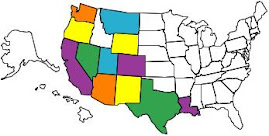Monday 17 May 2010
On the move!
I have recently transfered goin travlin' to a new blog site with Word Press. To continue following our travel stories this is the link to the site www.elainethehill.wordpress.com I hope you continue to enjoy our tales and like the new format where you can easily sign up to receive an e mail each time I post and post comments which we love to receive.
Saturday 8 May 2010
Along the Mississippi and the Natchez Trail
Leaving New Orleans behind we drove over one of the longest road bridges in
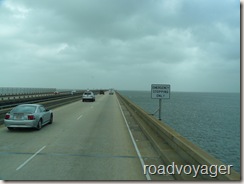 the US. Crossing Lake Pontachtrain on a grey morning it delivered us to the north shore and a campground there to take a couple of days rest after our busy days as tourists in the big city.
the US. Crossing Lake Pontachtrain on a grey morning it delivered us to the north shore and a campground there to take a couple of days rest after our busy days as tourists in the big city. Recuperated we made our way north following the mighty Mississippi river, we could however only snatch glimpses of it as it is safely tucked away behind the levee’s.
We did stop for lunch at one of the very large locks which allow the
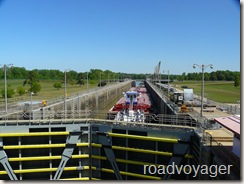 barges to travel down river towards the port of New Orleans. We were lucky enough to be able to see the boat in the lock as we passed over the bridge, you are not allowed to stop on the bridge so this quick shot was taken as we passed by.
barges to travel down river towards the port of New Orleans. We were lucky enough to be able to see the boat in the lock as we passed over the bridge, you are not allowed to stop on the bridge so this quick shot was taken as we passed by.We made our way to Vidalia on the Louisiana side of the river, to enable us to visit the town of Natchez on the Mississippi side. We stayed at Riverview RV Park ,a lovely
 campground overlooking the Mississippi and just below the bridge, with easy access to the river walk for an evening stroll. Unfortunately there were rather a lot of insects flying around while we were there so the air conditioning came into its own as the temperature fell little below 75 degrees overnight.
campground overlooking the Mississippi and just below the bridge, with easy access to the river walk for an evening stroll. Unfortunately there were rather a lot of insects flying around while we were there so the air conditioning came into its own as the temperature fell little below 75 degrees overnight.In the years before the Civil War Vidalia was a Cotton farming area, however on the lower bank of the river it regularly flooded, to avoid disaster the well to do farmers built grand homes on the Mississippi bank in Natchez and moved there at times of bad weather. Natchez became an elegant and prosperous City. Many of its beautiful homes still exist, after stopping at the visitor centre we took ourselves on a walking tour of the streets.
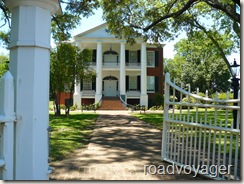

Huge magnolia trees line many of the streets and the scent of white jasmine was constantly in the air, lovely for me….. it made Robert sneeze!
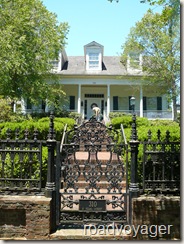
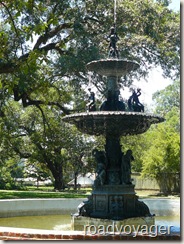
This three tier fountain in the Memorial Gardens(it stood about 20ft tall) was a pleasant cool spot under the trees not only for us to stop and enjoy but while I waited for Robert to take the pictures I watched as birds flitted in and out of the water catching insects and taking a drink.
 On the outer edge of town the National Park owns Melrose, a beautiful Greek revival style house presently undergoing some major restoration work. In the grounds the slave quarters and other outbuildings were open for viewing giving a view into the life of those who once lived there.
On the outer edge of town the National Park owns Melrose, a beautiful Greek revival style house presently undergoing some major restoration work. In the grounds the slave quarters and other outbuildings were open for viewing giving a view into the life of those who once lived there.A big part of Mississippi both then and now is Cotton and to get a better understanding of this fibre we know so well, but so little about, we visited the Frogmore Plantation to the west of Vidalia. The original Plantation house is still occupied by its present day owners who have gathered together from across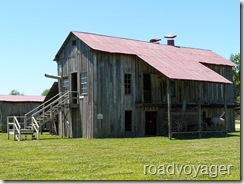 the State both buildings and artefacts to display the history of this plantation and cotton too.
the State both buildings and artefacts to display the history of this plantation and cotton too.
This old building houses the cotton gin and press
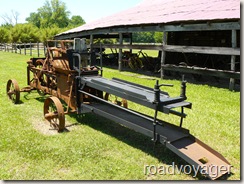
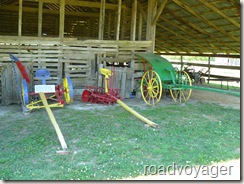
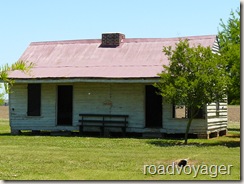
 the State both buildings and artefacts to display the history of this plantation and cotton too.
the State both buildings and artefacts to display the history of this plantation and cotton too.This old building houses the cotton gin and press



Small wooden buildings like this were the home for 6 to 8 slaves who worked on the farm, the overseer had much grander abode, but called the Dogtrot!!
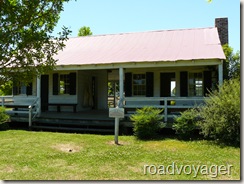
Inside were displayed all manner of things from the lives of these people, the
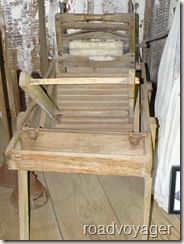 one which fascinated me most being this early washing machine. I am sure I could make use of this if we could just fit it in one of haRVey’s lockers.
one which fascinated me most being this early washing machine. I am sure I could make use of this if we could just fit it in one of haRVey’s lockers.We were shown two films narrated by the present owners, the first an excellent
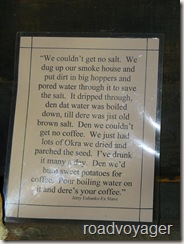 explanation of historical facts about the cotton plantations and the slaves. The second by her husband gave an insight to modern farming of cotton and it uses. In all an informative and entertaining place to visit and learn.
explanation of historical facts about the cotton plantations and the slaves. The second by her husband gave an insight to modern farming of cotton and it uses. In all an informative and entertaining place to visit and learn.While in the Natchez visitor centre we had discovered information about the Natchez Trace Parkway. In the mid 1800’s Flat bottom boats would float down the Mississippi river taking all manner of commodities to New Orleans. The strong flow of water prohibited these powerless vessels from returning up
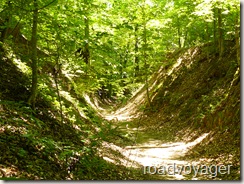 stream so they would be sold or broken up leaving their owners in need of a method to return north. Natchez was easily accessible due to goods being delivered there for the cotton farms, from there to Tennessee or Illinois was more difficult, a trail used by Indians became a walkway for their return journey.
stream so they would be sold or broken up leaving their owners in need of a method to return north. Natchez was easily accessible due to goods being delivered there for the cotton farms, from there to Tennessee or Illinois was more difficult, a trail used by Indians became a walkway for their return journey.Today a tarmac road criss crosses the old pathway, not destroying it but as part of its preservation. No commercial vehicles are allowed on the parkway, leaving the woodland and verges free of signage and pollution. The road runs
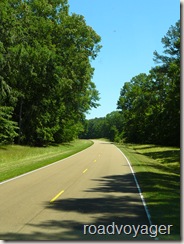 over 400miles from Natchez in the south to Nashville in the north, we decided we could take a ride in that direction. Vicksburg around 70 miles north was the next place we wanted to stop and this would be a good route for us. Our first 20 miles on the parkway took us to Natchez State Park campground for the night and those twenty miles were enough of an insight into the beauty of the road to get us hooked!
over 400miles from Natchez in the south to Nashville in the north, we decided we could take a ride in that direction. Vicksburg around 70 miles north was the next place we wanted to stop and this would be a good route for us. Our first 20 miles on the parkway took us to Natchez State Park campground for the night and those twenty miles were enough of an insight into the beauty of the road to get us hooked!Our first stop next morning was the Emerald Mound, an ancient Indian
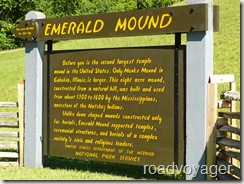 ceremonial ‘construction’. A natural hill was developed with earthworks to form a flat topped mound some 50ft high. We climbed the steps to the top and viewed the smaller mound a short way off and wondered about the ceremonies performed here. We later learned burials were amongst them.
ceremonial ‘construction’. A natural hill was developed with earthworks to form a flat topped mound some 50ft high. We climbed the steps to the top and viewed the smaller mound a short way off and wondered about the ceremonies performed here. We later learned burials were amongst them.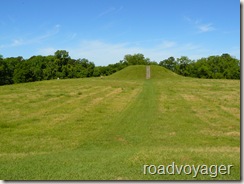
After this we drove to mile marker 15.5 and stopped to visit the Mount Locust
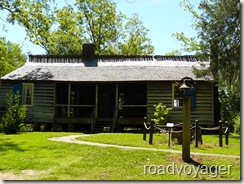 property. What was once a small farm became a regular stopping place for the increasing travellers on the trace and eventually the family prospered with the development of an Inn and the production of Cotton on the farm. Not like the grand house of Natchez, this was a true working plantation and seemingly quite rustic.
property. What was once a small farm became a regular stopping place for the increasing travellers on the trace and eventually the family prospered with the development of an Inn and the production of Cotton on the farm. Not like the grand house of Natchez, this was a true working plantation and seemingly quite rustic.With temperatures around 90degrees Fahrenheit in the daytime (30 C) , and not dropping much below 75 (24 C) at night, we have been glad of the air conditioning in haRVey to use this however we need a power supply, the National Park Campgrounds do not have have hook ups, but, they are free…
After a lovely mornings driving the very quiet road and lulled by the beauty of the surroundings we made the decision to stay at the Rocky Springs Campground. It was 87 degrees but we were in the shade of the tallest of trees so hoped we would cool down naturally and not miss our air conditioning!
We took a trail from the campground towards the ruins of the old town site, this would take us along parts of the original trace – this sign got us thinking! we appeared to be the only ones along the wooded walk, it was
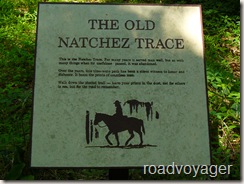 serenely quiet, I spotted a great horned owl, spying on us from a branch, he was huge, and my first sighting of a real owl. We disturbed a small herd of deer who took off into deeper woodland and all the while the numerous birds chirped and called around us.
serenely quiet, I spotted a great horned owl, spying on us from a branch, he was huge, and my first sighting of a real owl. We disturbed a small herd of deer who took off into deeper woodland and all the while the numerous birds chirped and called around us.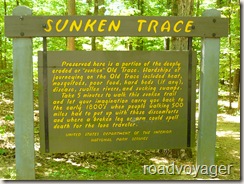
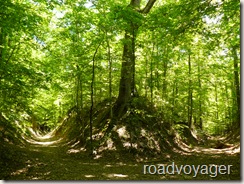
Back at the campground we melted away the evening waiting for the temperature to reduce and as darkness fell were mesmerized watching fireflies dancing in the dusk and on into dark. Like little sparks from a fire they darted all around us and we were pleased we had kept the windows open to view their entertainment.
Sunday 2 May 2010
New Orleans – Geeez Louise!
Foot sore and weary we arrived back from our days excursion to the French Quarter of New Orleans. Staying at the KOA gave us the opportunity to ride their free
 shuttle into town but when we boarded the mini bus at 9am we did not allow for the running commentary we were going to receive. So much information to take in all at once from our driver with a wealth of local knowledge. He dropped us off right on the banks of the Mississippi river just down from the Jackson Brewery building (converted to a shopping centre). One of our first sights was the St Louis cathedral and the horse and carriage rides lined up to take tourists around the city.
shuttle into town but when we boarded the mini bus at 9am we did not allow for the running commentary we were going to receive. So much information to take in all at once from our driver with a wealth of local knowledge. He dropped us off right on the banks of the Mississippi river just down from the Jackson Brewery building (converted to a shopping centre). One of our first sights was the St Louis cathedral and the horse and carriage rides lined up to take tourists around the city.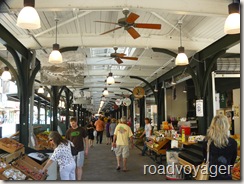 A few steps along the road we came to the French Market, obviously well restored after the 2005 hurricane Katrina had passed this way. It was still early and quiet, the stall holders dressing their stands waiting for the days visitors to arrive.
A few steps along the road we came to the French Market, obviously well restored after the 2005 hurricane Katrina had passed this way. It was still early and quiet, the stall holders dressing their stands waiting for the days visitors to arrive.We walked back a block from the market and began to see the properties the
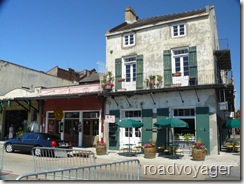 area is so famous for, many still empty or needing repair others beautifully restored to perhaps better than they were.
area is so famous for, many still empty or needing repair others beautifully restored to perhaps better than they were.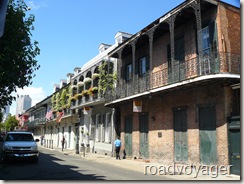
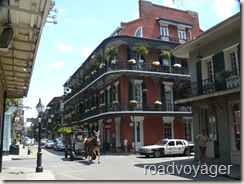
Really the only way to see the sights is on foot, unless of course you take a horse drawn carriage tour, even then they pass by the alleyways so quickly you
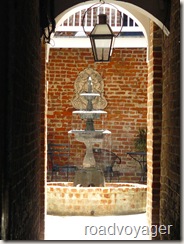 would not get to glimpse the courtyards hidden away behind the buildings.
would not get to glimpse the courtyards hidden away behind the buildings.This looked oh, so inviting, however, they had lovely salads or coffee time treats, we wanted something a little more substantial to avoid cooking in the evening, so sadly we walked on.
As the day wore on, our camera groaning with the captured images we got on a trolley bus to give the feet a rest. We took the route along St Charles Avenue
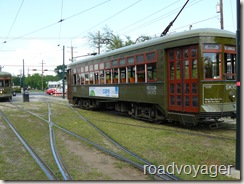 riding into the outer suburbs of New Orleans. This area was largely untouched by Katrina, its grand properties some which date back to pre Civil war times sit behind huge oak and magnolia trees. The tram cost $1.25 a ride or for $5 you can get on and off all day any of the three routes around the city. An excellent way to see beyond the immediately obvious and tourist hotspots.
riding into the outer suburbs of New Orleans. This area was largely untouched by Katrina, its grand properties some which date back to pre Civil war times sit behind huge oak and magnolia trees. The tram cost $1.25 a ride or for $5 you can get on and off all day any of the three routes around the city. An excellent way to see beyond the immediately obvious and tourist hotspots.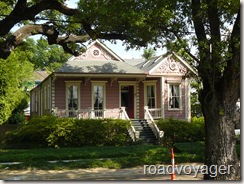
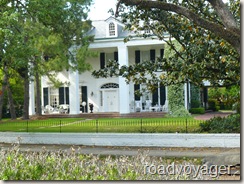
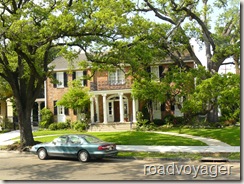
Back in the main part of town we took a walk out to the levee to catch a breath of cooler air.
As we had walked in the French Quarter earlier in the day a ‘musical’ sound had caught our ear, I thought it was coming from one of the upper floors and described it as children practicing the recorder. The music seemed to follow us around without us ever getting to the source, it was everywhere but
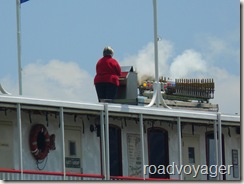 from no where in particular.
from no where in particular.Now we found its source, the paddle steamboat moored on the banks of the levee awaiting passengers to take a ride up the Mississippi, had, right on the top deck an instrument (it has a proper name we cannot remember) it looked a bit like an organ.
It played tunes like Swanee River, The Entertainer and of course Mississippi, with each note a puff of steam rising from its pipes, captivating even if it did regularly hit bad notes.
We watched as the passengers boarded, many school children and students excitedly hanging over the rail and watching the paddle
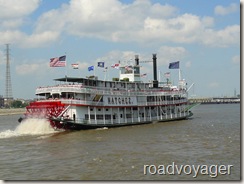 going around as they waited for the mooring ropes to be cast off. Eventually it set sail along the muddy waters in a strong breeze.
going around as they waited for the mooring ropes to be cast off. Eventually it set sail along the muddy waters in a strong breeze.Our first day almost over we caught our return shuttle bus at 5.45pm wondering if the feet would take another day but knowing there was plenty left to see. The return journey was equally as entertaining as the mornings had been our driver continued to bombard us with snippets of information only a resident would know. Our brains by now were so numb I think we took in even less of our lecture than in the morning, however his regular expletive of geeez Louise! at the other drivers or construction congestion or whatever took his dislike I found very amusing.
It is amazing what a nights sleep can do, at 9am on Friday morning we again boarded the shuttle bus. A new driver today and a new commentary, a little more sedate thankfully and we were able to take in a few more details. We wanted to visit the Jean Laffite Museum for information on the history of New Orleans but first we thought we would treat ourselves to coffee and beignet's at the Cafe Du Monde, a local favourite. We found a huge queue waiting to be seated, this being 9.45 we were very surprised, the previous day there had been very few people around until after lunchtime. We passed over the coffee.
The museum was interesting and well laid out with history of how Louisiana changed hands from the Spanish and French to the English and eventually became a part of the United States. Cultural history about sugar and cotton plantations and of course the slaves and their fight to become free. We later visited the State Museum too, a little more formal in the way the information is presented but containing some fascinating artefacts like Napoleon’s death mask!
Again looking for lunch we thought we were going to a vegetarian restaurant we
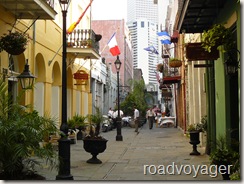 had found down one of the side streets late the day before but there were no tables free. Around the corner we found Bacco, the restaurant of Ralph Brennan a well known chef here. As it had been recommended by our driver, it did not take long to make a decision that this was the place to eat. We were not disappointed by the food and pleasantly surprised at the cost, a 2 course lunch special for $15. We passed on the desert but did not miss out as later in the afternoon we managed to get seats in Cafe Du Monde for that coffee and beignet treat we missed first thing.
had found down one of the side streets late the day before but there were no tables free. Around the corner we found Bacco, the restaurant of Ralph Brennan a well known chef here. As it had been recommended by our driver, it did not take long to make a decision that this was the place to eat. We were not disappointed by the food and pleasantly surprised at the cost, a 2 course lunch special for $15. We passed on the desert but did not miss out as later in the afternoon we managed to get seats in Cafe Du Monde for that coffee and beignet treat we missed first thing.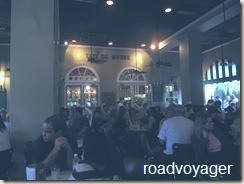
A great experience to visit New Orleans, to see how it has largely recovered from the bombardments of hurricanes, but so sad to think that while we were enjoying ourselves another disaster was inching its way towards the coast in the form of the oil slick from the broken well in the Gulf. From the fishermen
 through to the restaurants and all associated trades everyone will feel the impact. The wonderful wildlife and natural areas of the coastal inlets which we have so enjoyed are all in danger of being spoiled for many years to come.
through to the restaurants and all associated trades everyone will feel the impact. The wonderful wildlife and natural areas of the coastal inlets which we have so enjoyed are all in danger of being spoiled for many years to come.
Subscribe to:
Posts (Atom)

